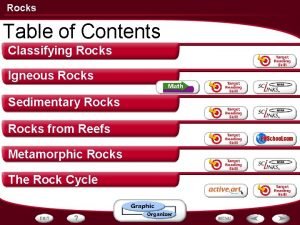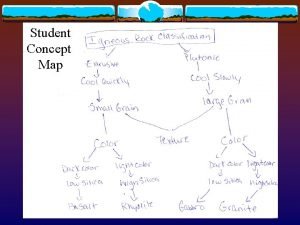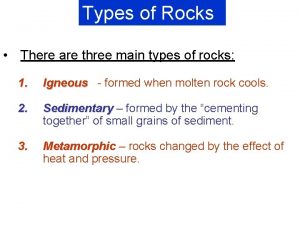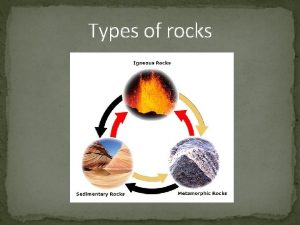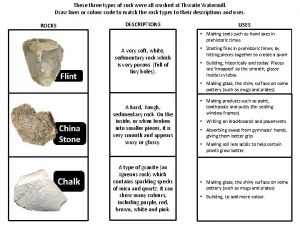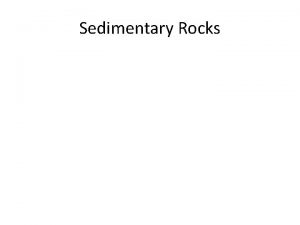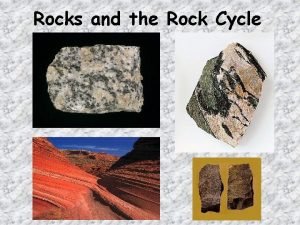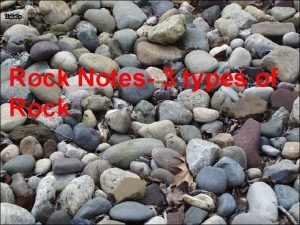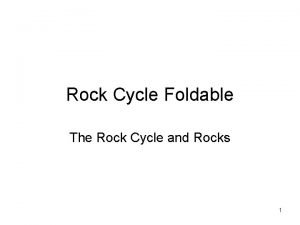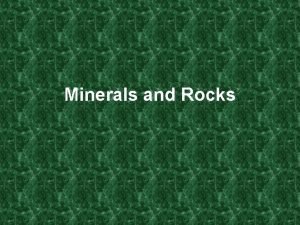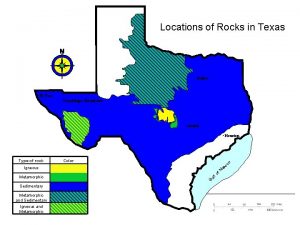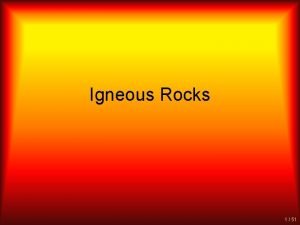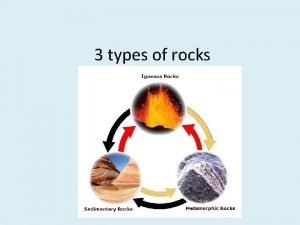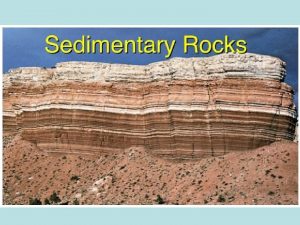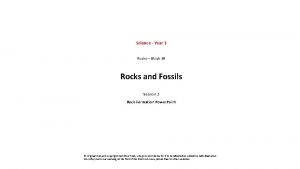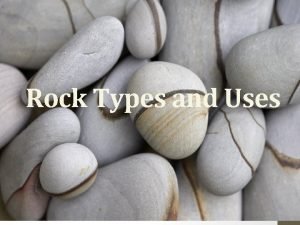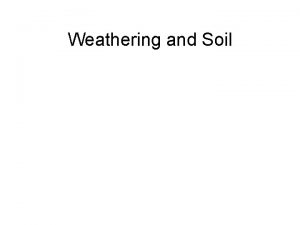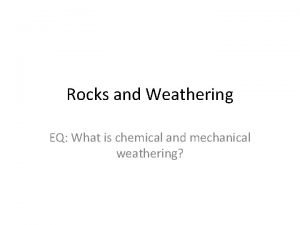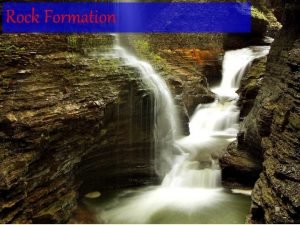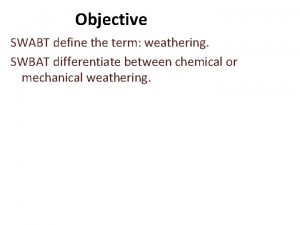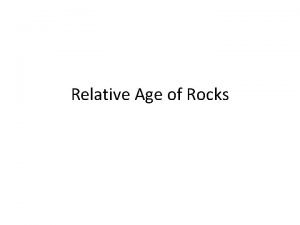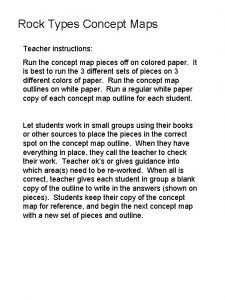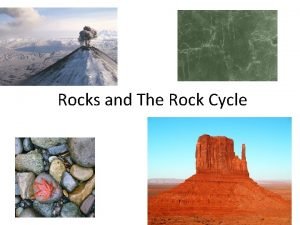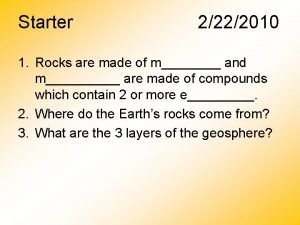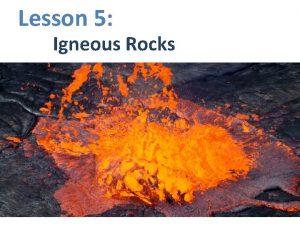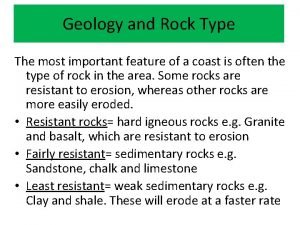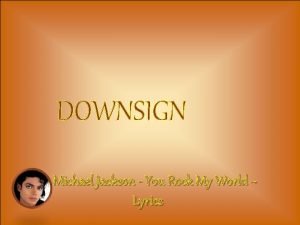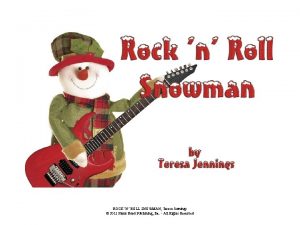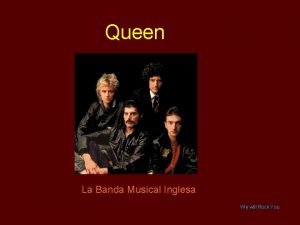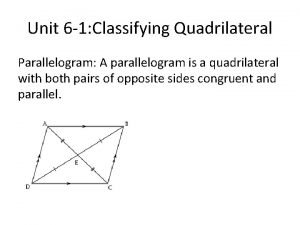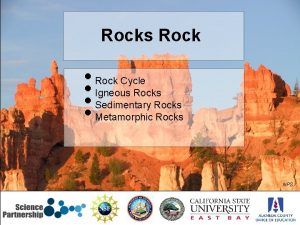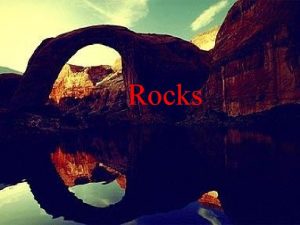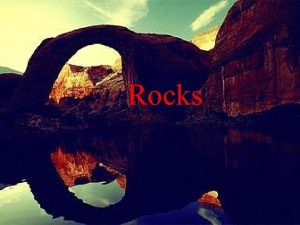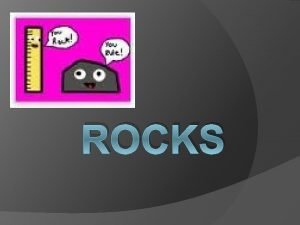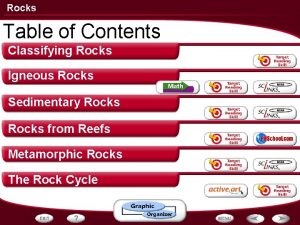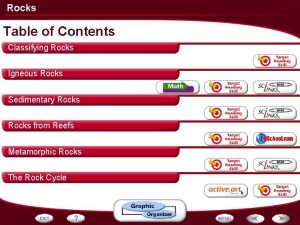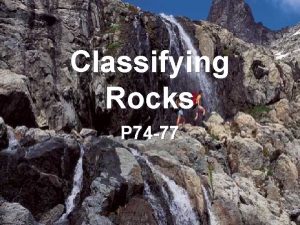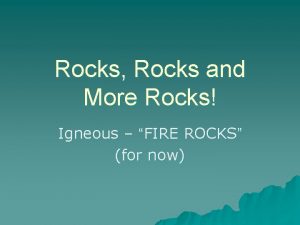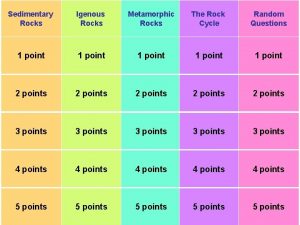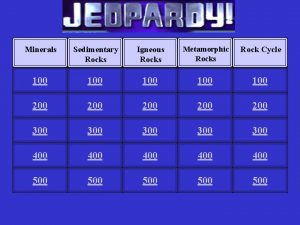Types of Rock Classifying Rocks What you will























































- Slides: 55

Types of Rock

Classifying Rocks- What you will learn The contribution of minerals to rock composition. 2. Classify rocks by their process of formation. 3. Describe processes that change rocks and the surface of the earth. 1. More specifically: 1. 2. Characteristics used to identify rocks Identify and describe the 3 major rock groups.

What are Rocks? A rock is a naturally occurring solid mixture of one or more minerals, or organic matter Earth’s crust is made of rocks. Rocks are classified by how they are formed, their mineral composition, and their texture Rocks change over time through the rock cycle

Rocks are made of mixtures of minerals and other materials. 2. Ex: granite is made of the minerals quartz, feldspar, hornblende, and mica. 1. What is the difference between a rock and a mineral? 4. Mineral- is naturally occurring and cannot be made of once living things. 5. A rock can have minerals in it, but minerals will NEVER have rocks in them. 3. 6. Scientists classify rocks by color, mineral composition, and texture.

Rocks

Color A rock’s color provides clues to the rock’s mineral composition 2. Ex: granite is lightcolored rock that has high silica content. 3. Ex: basalt is a dark colored rock that is low in silica. 1.

Texture - Grain size Particles of minerals and other rocks that make up a rock are called grains. 2. Grains give the rock its texture- the look and feel of the rock’s surface. 3. Ex: smooth or rough, glassy or chalky. 4. Page 56 1.

Texture- Grain Size 1. Grain size a. Large and easy to see- course-grainedex: diorite b. Small- fine grained- ex: slate c. No visible grain- ex: flint

Grain Shape- What determines the grain shape of a rock? Grain shape results from the fragments of several rocks or the shapes of the crystals that form the rock. 2. Rounded grainex: conglomerate 3. Jagged grainex: Breccia 1.

What determines the grain shape of a rock? Conglomerate is determined by the shape of the fragments of other rock. Granite is determined by the shape of the rock’s crystals.

Grain Pattern Nonbanded- (nonfoliated) ex: quartzite- no grains b/c it cooled very quickly. 2. Banded- ( foliated) ex: gneiss - different colors in the bands. 1.

Review- Be the teacher What are three ways geologists classify rocks? 2. What does banded and nonbanded mean? 3. What does course grained and fine grained mean? 4. Name an example of a rounded grain rock and a jagged grained rock? 1.

How Rocks Form 1. Geologists classify rocks according to their origin (how they formed). Three groups are: a. Igneous Rocks- forms from cooling of magma/lava. Ex: granite and basalt b. sedimentary rock- forms when particles of other rocks are pressed and cemented together. Ex: conglomerate and limestone c. metamorphic rock- forms when a rock is changed by heat and pressure. Forms deep underground. Ex: gneiss and shale

Igneous Rocks Igneous rock begins as magma or molten rock. Magma can form: ▪ When rock is heated ▪ When pressure is released ▪ When rock changes composition http: //www. fi. edu/fellows/payton/rocks/create/igneous. htm

Igneous Rocks- Two Types Intrusive Igneous Rocks: magma cools below (INSIDE) the Earth’s surface Extrusive Rocks: forms when magma erupts OUTSIDE (EXIT) the Earth’s surface (lava), cools quickly with very small or no crystals formed http: //www. windows. ucar. edu/tour/link=/earth/geology/ig_intrusive. html&edu=high&fr=t

Basalt vs. Granite (#4, 5, 6, 11, 13) The texture depends on the size and shape of the crystals. BASALT GRANITE dark colored (mafic) forms from lava forms the ocean’s crust (floor), shield volcanoes, and lava plateaus It is the most common extrusive igneous rock. light colored (felsic) forms from magma forms the core of mtn ranges It is the most abundant intrusive rock in the crust.

Igneous Rocks (#8, 9, 16) Felsic: light colored rocks that are rich or high in silica(silicon and oxygen). Mafic: dark colored rocks that are poor or low in silica. Coarse-grained: takes longer to cool, giving mineral crystals more time to grow (bigger crystals) Fine-grained: cools quickly with small or no crystals

Igneous Rocks –the texture depends on the size and shape of its crystals. Coarse-Grained Fine-Grained Felsic Granite Rhyolite Mafic Gabbro Basalt

Porphyry Large crystals surrounded by small crystals. Cools in two stage, quick then slow. Looks like Jello filled with fruit

Igneous Rocks Obsidian is a dark-colored , smooth and shiny volcanic glass that forms from the very rapid cooling of molten rock material. It cools so rapidly that crystals do not form. Is this rock Felsic or Mafic? Is it fine-grained or coarse-grained? Is this rock Intrusive or Extrusive? Mafic, fine grained, extrusive

Minerals of Granite Minerals determine the color of rocks. Ex: Reddish granite is rich in feldspar and is speckled pink. Hornblende and dark mica cause granite to be light gray with dark specks. Quartz makes with light gray or smoky specks. Geologists take thin slices of granite and study them under the microscope to determine its mineral composition.

Uses of Igneous rocks are hard, dense, and durable. Thus the reason they were used in building materials. Several ways igneous rocks have been used are: Egyptians used them to build statues Incas used them to build a fortress near their capital city United States used them to build bridges and buildings and to pave streets with cobblestones in the 1800’s and early 1900’s.

Uses of Igneous Rocks Basalt is used for gravel for construction and also for soil mixes. Pumice is used for cleaning and polishing.

Igneous Rocks

Review- Be the teacher How are igneous rocks made? If a rock is course grained, did it cool fast or slow? What about fine grained? 3. What are the two types of igneous rocks and where did they form? 1. 2.

Sedimentary Rocks Sediment includes small, solid pieces of rock, minerals, and organic matter such as shells, bones, leaves, and stems. Water and wind deposit particles that form sedimentary rocks. Running water, wind, and ice carry sediment from one place to another.

When sediments are pressed and squeezed together, compaction takes place. When dissolved minerals naturally glue sediments together, cementation takes place. Rock fragments that are carried by water eventually sink to the bottom of a lake or ocean.

Sedimentary Rocks Sedimentary rock is formed by erosion Sediments are moved from one place to another Sediments are deposited in layers, with the older ones on the bottom The layers become compacted and cemented together which then turn in to sedimentary rock. • This takes millions of years. http: //www. fi. edu/fellows/payton/rocks/create/sediment. htm

Sedimentary Rock Sedimentary Rocks are formed at or near the Earth’s surface No heat and pressure involved Strata – layers of rock Stratification – the process in which sedimentary rocks are arranged in layers

Sedimentary Rocks Geologists classify sedimentary rocks according to the type of sediments that make up a rock. Three Types C – O- C 1. Clastic 2. Organic 3. Chemical Different processes form each type of sedimentary rock.

Sedimentary Rock Clastic – made of fragments of rock squeezed and cemented together with calcite or quartz. Breccia is a term most often used for clastic sedimentary rocks that are composed of large angular fragments (over two millimeters in diameter). The spaces between the large angular fragments can be filled with a matrix of smaller particles or a mineral cement that binds the rock together.

Clastic Sedimentary Rock They are classified by the SIZE of the rock fragments. EX: Tiny particles of clay is shale Sandstone is small particles of sand Conglomerate is different sized rock fragments.

Sedimentary Rock Organic sedimentary – remains of plants and animals Ex: coal and limestone Coal is an organic sedimentary rock that forms from the accumulation and preservation of plant materials, usually in a swamp environment. Coal is a combustible rock and along with oil and natural gas it is one of the three most important fossil fuels.

Organic Limestone Shells from living things pile up on the ocean floor in layers. Compaction and cementation change sediments to limestone.

Sedimentary Rock Chemical sedimentary – minerals crystallize out of solution to become rock. Mineral deposits forms when seas or lakes evaporate. Limestone is also a chemical sedimentary rock composed primarily of calcium carbonate (Ca. CO 3) in the form of the mineral calcite. It most commonly forms in clear, warm, shallow marine waters. It is usually an organic sedimentary rock that forms from the accumulation of shell, coral, algal and fecal debris.

Rock Salt crystallizes from the mineral halite. Sandstone and limestone are soft enough to be cut easily into blocks or slabs. That’s why they have been used as building materials for thousands of years. The White House in Washington D. C. is made of sandstone.

People use sandstone and limestone today to decorate or cover the outside of walls of buildings. Cement is made out of limestone.

Sedimentary Rocks 1

Sedimentary Rock

Review-Be the teacher 1. 2. How do sedimentary rocks form? Name the category for each rock: clastic, organic, or chemical 1. Coal 2. Conglomerate 3. Limestone

Metamorphic Rock Meaning to change shape Changes with temperature and pressure, but remains solid Usually takes place deep in the Earth http: //www. fi. edu/fellows/payton/rocks/create/metamorph. htm

Metamorphic Rocks Contact Metamorphism – heated by nearby magma Increased temperature changes the composition of the rock, minerals are changed into new minerals Hornfeld is a fine-grained nonfoliated metamorphic rock produced by contact metamorphism http: //www. windows. ucar. edu/tour/link=/earth/geology/meta_contact. html&edu=h igh&fr=t

Metamorphic Rocks Regional Metamorphism – pressure builds up in rocks that is deep within the Earth Large pieces of the Earth’s crust collide and the rock is deformed and chemically changed by heat and pressure http: //www. windows. ucar. edu/tour/link=/earth/geology/meta_regional. html&edu=high&fr=t

Metamorphic Rocks Two Types 1. Foliated (banded) 2. Nonfoliated (nonbanded)

Metamorphic Rock Foliated (banded) - contain aligned grains of flat minerals (it forms layers). Gneiss is foliated metamorphic rock that has a banded appearance and is made up of granular mineral grains. It typically contains abundant quartz or feldspar minerals.

Metamorphic Rock Non-Foliated (nonbanded)– mineral grains are not arranged in plains or bands Marble is a nonfoliated metamorphic rock that is produced from the metamorphism of limestone. It is composed primarily of calcium carbonate.

Metamorphic Rock Determine if the following rock samples are foliated or non-foliated: Amphibolite Quartzite Phyllite Foliated

Metamorphic Rock

Metamorphic Rocks 1

Rocks and Minerals- A Review

Review- Be the teacher 1. 2. 3. How do metamorphic rocks form? What does foliated and nonfoliated mean? Give an example of a foliated rock and a nonfoliated rock in that order.

Videos www. brainpop. com Types of Rock Cycle

Rock Cycle

Uses of Rocks

Rock Songs- youtube http: //www. youtube. com/watch? v=rk. GVE 6 w NAzo - Mr. Lee http: //www. youtube. com/watch? v=l. E 3 j. R_Rh x. O 4 – Mr. Parr
 Igneous rocks metamorphic rocks and sedimentary rocks
Igneous rocks metamorphic rocks and sedimentary rocks Igneous rocks metamorphic rocks and sedimentary rocks
Igneous rocks metamorphic rocks and sedimentary rocks Classifying rocks
Classifying rocks Igneous rocks
Igneous rocks Classifying rocks
Classifying rocks Extrusive rock
Extrusive rock Rhyolite lame mince
Rhyolite lame mince Concept map about rocks
Concept map about rocks Concept map about rocks and minerals
Concept map about rocks and minerals A picture of a rock cycle
A picture of a rock cycle How can one type of rock change into another type of rock?
How can one type of rock change into another type of rock? Rock climb
Rock climb A rock climber's shoe loosens a rock and her climbing buddy
A rock climber's shoe loosens a rock and her climbing buddy Chapter 3 standardized test practice answers
Chapter 3 standardized test practice answers You light up my life classifying substances answer key
You light up my life classifying substances answer key 3 main types of
3 main types of How are rocks formed
How are rocks formed Three types of rocks
Three types of rocks Name
Name What are sedimentary rocks
What are sedimentary rocks Three types of rocks
Three types of rocks 3 rock types
3 rock types Types of rocks foldable
Types of rocks foldable Luster streak
Luster streak Rocks in texas
Rocks in texas The formation of igneous rocks
The formation of igneous rocks Sedimentary rocks examples
Sedimentary rocks examples How do the rocks stick together to undergo lithification?
How do the rocks stick together to undergo lithification? Different types of rocks year 3
Different types of rocks year 3 Granite and pumice
Granite and pumice Rock cycle crayon lab answer key
Rock cycle crayon lab answer key What type of rock is this
What type of rock is this Kind of weathering
Kind of weathering Kinds of weathering
Kinds of weathering Properties of sedimentary rocks
Properties of sedimentary rocks Types of rocks foldable
Types of rocks foldable What is weathering and its types
What is weathering and its types What is reletive age
What is reletive age Igneous rock concept map
Igneous rock concept map Marble and slate
Marble and slate Rock types and cycle quick check
Rock types and cycle quick check Igneous rock types
Igneous rock types Difference between pumice and scoria
Difference between pumice and scoria Swanage bay geology
Swanage bay geology Rain
Rain Good health is a choice agree or disagree
Good health is a choice agree or disagree If you think you can you can poem
If you think you can you can poem Tell me what you eat and i shall tell you what you are
Tell me what you eat and i shall tell you what you are I will follow you wherever you may go
I will follow you wherever you may go You rock my world lyrics
You rock my world lyrics Rock and roll snowman
Rock and roll snowman Banda británica de rock you
Banda británica de rock you Firm foundation
Firm foundation Which is not a rhombus
Which is not a rhombus Proving triangles are congruent maze 1
Proving triangles are congruent maze 1 Common characteristics of triangle and quadrilaterals
Common characteristics of triangle and quadrilaterals



